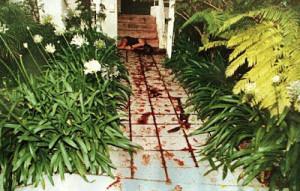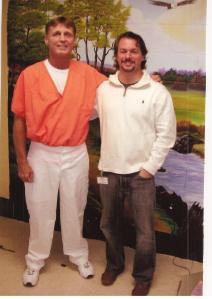Who Killed Nicole?

Nicole Brown Simpson’s Body at her Bundy Home
A serial killer claims credit for the Simpson/Goldman double homicide.
Confessions come out of the woodwork in high profile cases: the Lindbergh kidnapping, the Black Dahlia murder, and JonBenet Ramsey all attracted voluntary confessors, but most just craved an association with fame. John Mark Karr had even picked out Johnny Depp to play him in the inevitable movie about the murder of young JonBenet. And then there’s the Nicole Brown Simpson/Ronald Goldman double homicide from 1994. We have a suspect who’s once again getting some attention, compliments of Anthony Meoli.
A consultant with a master’s degree in forensic psychology, Meoli has corresponded with and interviewed numerous serial killers and death row inmates. Among them are Danny Rolling, Loran Cole, and Lee Boyd Malvo. Next week, Meoli is set to appear on My Brother, the Serial Killer (Nov. 21) on the ID Network regarding his interviews with serial killer Glen Rogers.
It’s not the first time that Rogers, convicted of three murders, has been in the picture for this infamous double homicide. However, Meoli has information that suggests we should reconsider past dismissals of Rogers’ claim. I invited him to tell me more about it.

Rogers and Meoli
“My motivation for writing Glen Edward Rogers,” Meoli said, “was triggered after reading several Internet articles and a book about his crimes. What really garnered my attention was that he had been tried, convicted and sentenced to death in not one state but two – Florida and California. The fact that California was willing to extradite an already convicted man from Florida’s death row made me curious as to what had happened in all the states in between. It seemed, at least from a cursory review of some of the cold cases surrounding him, wherever Glen Rogers went, someone either ended up missing or dead. What I would find was rather astounding.”
I asked about the start of their correspondence.
“My first letter from Glen was received on October 4, 2009,” said Meoli, “as he sat on death row at Union Correctional Institution in Raiford, Florida. He responded by saying, ‘I received your letter a while back and debated about writing back because someone in Georgia had caused other inmates lots of trouble.’ I dispelled his fear with my next letter, knowing that trust had been a core issue with Glen his entire life, and he was quick to respond. By the end of 2009, he’d written an additional seven times. A bond had been struck between us, what it was I cannot explain, but it was set.”
Rogers soon started writing on a regular basis, two or three times a week. Meoli said that on May 6, 2010, a revealing letter arrived.
“It concerned his first murder as a teenager, with his father. After twelve years of writing to death row inmates, I’d grown accustomed to ‘stories’ about unsolved crimes (often these boastful claims are merely a test or a ruse to elicit money to get more details), but his letter seemed different. Glen narrowed the year to between 1975-1976 and described the female victim in vivid detail. He also described the car that they’d used and where he and his father had buried the woman. He asked me to look up this cold case to see if this woman had ever been found. Glen even hinted at an ability to draw her face, which I convinced him to do and which was sent about a month later.”
Within about six weeks, Meoli sent Rogers a second questionnaire. With it he asked Rogers if he had anything to do with the 1994 Brown Simpson/Goldman murders?
“Surprisingly,” Meoli told me, “he answered in the affirmative. Glen began divulging more information about his past crimes and his family. Each letter was now 5-10 pages in length.”
Rogers placed Meoli on his visitation list, and on November 6, 2010, they met for the first time. Because Meoli had requested special approval, he was able to spend several hours.
“It was during this visit that Glen described how he became involved in the Goldman/Simpson murders. He explained that he’d detailed his involvement in some of the art he’d sent me prior to my visit and if I looked closely I would see the clues. In a July 2010 drawing, he’d depicted the basic design of the murder weapon along, with the victims’ skulls.”
Post-visit, another drawing also depicted the weapon. Rogers had killed Goldman, first, he’d said, which had drawn Nicole outside.
“This was a murder-for-hire plot,” Meoli stated. “Glen explained that it was designed to be inside the condo, but Goldman arrived to the wrong place at the wrong time. Since Rogers was a much larger man, standing nearly 6’2” and 240 lbs, he’d subdued Goldman without leaving much evidence.”
This, apparently, was his MO: leaving little evidence. Other artwork depicted other murders, seemingly taking place over several decades – many more than the three for which he’d been charged and convicted.
“Considering that most death row inmates usually remain quiet, especially in Florida, and especially those who are well past the average time of execution,” said Meoli, “I found it peculiar that Rogers was readily admitting his alleged involvement in the Goldman/Simpson murders, and others. Why Rogers has kept up his insistence on these murders remains a mystery.”
Meoli has spent nearly 50 hours during eight visits with Glen Rogers. He insists that he’s detected no malingering during Rogers’ repeated recollections of this infamous night. “Glen has had time to believe it.”
Meoli points out that Rogers had lived in California at the time of the murders, just 25 minutes away from the scene. He’d worked for a painting company that had performed an estimate on Nicole’s condominium. The truck used for work was identified by a detective as one of the vehicles at the scene, (a white, Ford F-350, primarily used by contractors) along with an unidentified strand of long blonde hair allegedly found beneath under Nicole Simpson’s body, which was not hers. At the time, Rogers had long blonde hair.
Yet, what about the DNA evidence against OJ – the stuff that wasn’t contaminated or problematic?
“Rogers admits O.J. is not innocent,” Meoli counters, “but says he did not commit the murders. If we look at the case for which O.J. Simpson was convicted in Nevada, he hired someone to do his dirty work. So, is Rogers the actual perpetrator of the ‘Crime of the Century?’ It is my professional opinion that Glen Edward Rogers believes this to be the case. As to why he is so vehement about implicating himself, it remains a mystery. It could be a ruse to buy him more time or, as he puts it, ‘I needed to tell the world what happened.’”
It’s about time that some crew at ID put this case together for the rest of us to ponder. Since Meoli has collected so much information, I, for one, am looking forward to watching it.
_____
Dr. Katherine Ramsland has published 46 books and over 1,000 articles. She teaches forensic psychology and her area of specialization is serial murder. Her latest book on the subject is The Mind of a Murderer.
